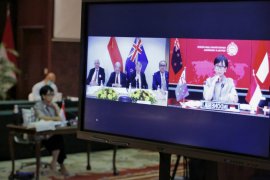In the midst of various global uncertainties, Indonesia was still able to record an impressive performance in terms of the trade balanceJakarta (ANTARA) - Coordinating Minister for Economic Affairs Airlangga Hartarto believes that the trade balance surplus in 2021 will boost resilience of Indonesia's external sector to make it stronger to face challenges in 2022.
"In the midst of various global uncertainties, Indonesia was still able to record an impressive performance in terms of the trade balance. This performance will increase the resilience of Indonesia's external sector, so that we are stronger in facing various challenges that are expected to continue this year," Hartarto noted in an official statement received here on Tuesday.
In 2021, Indonesia's trade balance surplus was recorded at US$35.34 billion. The surplus value is the highest on record since the last 15 years or since 2006 when the trade surplus had reached $39.37 billion.
The surplus performance during 2021 was supported by the export value that had reached $231.54 billion, or grew by 41.88 percent year-on-year, and was driven by exports of downstream superior commodities, such as crude palm oil (CPO).
This encouragement is apparent from the exports of animal fats and oils or vegetable oils, which during 2021, had reached $32.83 billion, or an increase of 58.48 percent year-on-year.
Apart from CPO, Hartarto noted that the downstream nickel commodity also strengthened Indonesia's export performance, with the export growth of nickel and processed goods from these commodities growing by 58.89 percent year-on-year to $1.28 billion.
"This achievement indicates that Indonesia's economic recovery continues, which is also reflected in the increased creation of added value in the manufacturing sector. Cumulatively, non-oil and gas exports from the processing industry from January to December 2021 rose 35.11 percent year-on-year to US$177.11 billion," he remarked.
The value of Indonesia's imports in 2021 also increased to $196.20 billion, or grew 38.59 percent year-on-year.
Indonesia's import structure in 2021 was dominated by the imports of raw materials and auxiliary materials of 75.12 percent from the total imports, followed by capital goods of 14.59 percent of the total imports, and consumer goods of 10.29 percent of the total imports. This structure indicates that the Indonesian economy has been productive in creating added value, both for domestic and export needs.
The consistent decline in COVID-19 cases in the last few months in 2021 prompted the government to impose easing restrictions on mobility, so that economic activity runs more smoothly.
However, Hartarto said he would remain vigilant about the potential spike in cases of the Omicron variant of COVID-19, which is expected to peak at the end of January or early February 2022.
"With the increasingly effective control of COVID-19 and good anticipatory measures against the spread of the Omicron variant, along with the implementation of strict health protocols, we are optimistic that COVID-19 cases will continue to decline, so that these developments are able to accelerate economic recovery. The trade surplus that continues to be stable in 2021 is also due to the solid performance of Indonesia's leading commodity exports," he stated.
Hartarto affirmed that the positive performance of the trade balance in 2021 will continue to be maintained by optimizing various policies, especially in encouraging more exports of value-added commodities.
Hartarto added that positive performance of the trade balance in 2021 will continue to be maintained by optimizing various policies, especially in encouraging more exports of value-added commodities.
Related news: Indonesia's trade balance reaches US$35.34 billion in 2021
Related news: Finance Ministry projects positive export-import performance
Related news: Indonesia records $5.73-billion trade balance surplus in October 2021
Translator: Katriana
Editor: Sri Haryati
Copyright © ANTARA 2022










